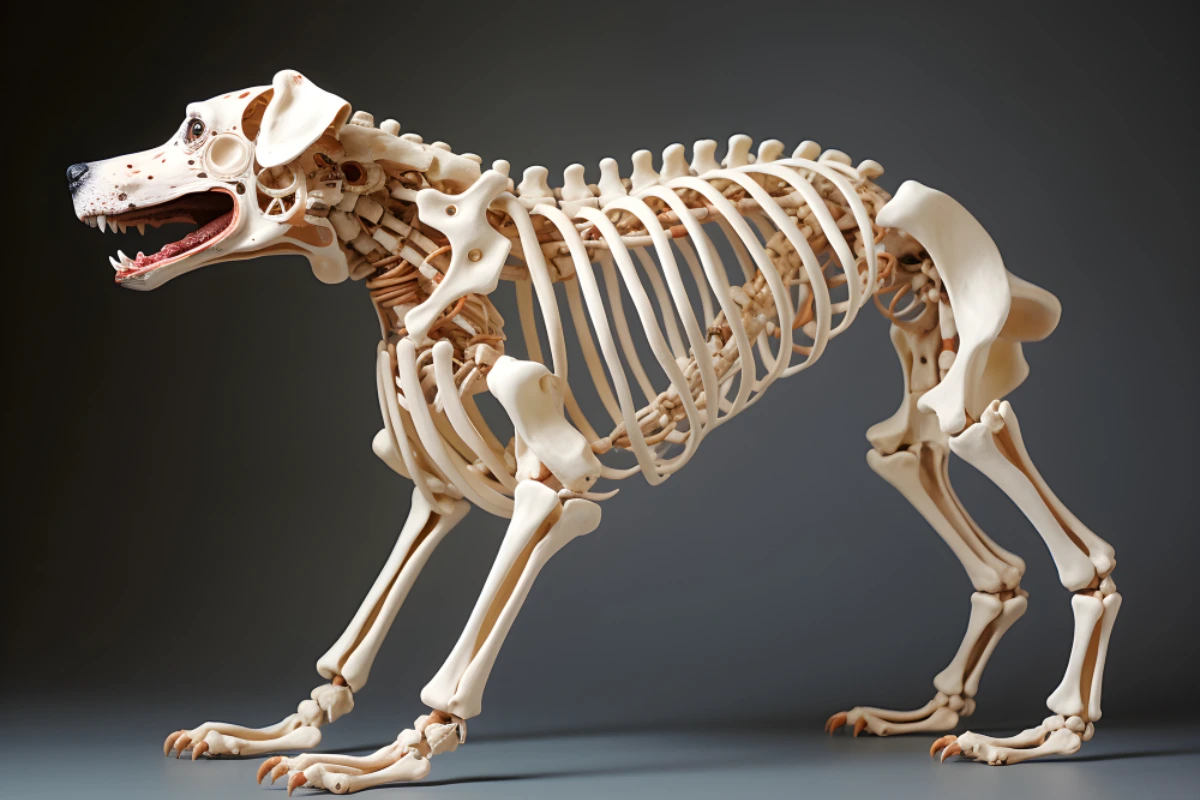Did you know that the dog’s skeleton is as unique as their Personality?
Understanding the bone structure of a dog is not much important but it’s very crucial when it comes to your dog’s health and mobility. Small size dogs to sized dogs there is a much difference in their bone structure it depends on the breed type and size of the dog.
In this guide, we will explore how many bones a dog has and bone development process of puppies to adults also breaks down the dog’s Skeleton.
How Many Bones Does a Dog Have?

Before knowing the fact that how many bones does a dog have there is a very interesting thing the number of bones in dogs depends on the length of their tail. Most dogs have 319 to 321 bones which is much more than humans as Humans have 206 Bones. Dogs have more bones due to the composition of their tails and limbs, which are designed to give them superior mobility and agility.
1. Variation Across Breeds
Larger dogs have more bones in their tails, while smaller breeds have fewer. This variance doesn’t significantly affect their overall health but does contribute to differences in movement and agility between the breeds.
2. Comparison To Human
Dogs have more bones than humans they have more bones in their tails and jaws compared to humans who have most of their bones in their hands and feet.
The Bone Development Process
1. Bone Formation in Puppies
Puppies are born with more soft cartilage than hard bones, just like human babies. As they grow, the soft parts slowly turn into bones, giving them a strong skeleton to support their body when they are adults. This process of bone forming is called ossification.
2. When Do Dogs Reach Full Skeletal Maturity?
A dog’s bones continue to grow after birth, typically until around 24 months. The growth of a dog’s bones depends on its size and breed. Small to medium-sized dogs usually reach full skeletal maturity within 15 months, while larger dogs take more time to fully develop their mature skeleton.
3. Importance of Proper Nutrition During Growth
Just like humans, dogs need proper nutrition to ensure healthy bone development. A diet that contains calcium, vitamin D, and phosphorus is essential for puppies to develop strong bones and avoid developmental issues like bone Defects or fractures.
Breakdown of the Dog’s Skeleton
A dog’s skeleton can be divided into several important sections, each serving a unique function to support the animal’s movement, flexibility, and protection of vital organs.
1. Skull
The dog’s skull houses and protects the brain. It also supports the jaw, helping with biting and chewing.
2. Spine (Vertebrae)
Dogs have about 50 vertebrae that make up the spine, offering flexibility and movement. The vertebrae are segmented into cervical, thoracic, lumbar, sacral, and caudal regions.
3. Ribs
A dog has 13 pairs of ribs that protect vital organs like the heart and lungs. The ribcage structure also supports breathing and provides a solid framework for muscle attachment.
4. Limbs (Forelimbs and Hindlimbs)
- The forelimbs consist of bones such as the humerus, radius, and ulna.
- The hindlimbs consist of bones such as the femur, tibia, and fibula.
- These bones are crucial for a dog’s locomotion, allowing them to run, jump, and walk efficiently.
5. Tail
The tail is made up of caudal vertebrae, and the number of bones can range from 5 to over 20, depending on the breed and length of the tail. Dogs use their tails for balance, communication, and even during swimming.
Comparing Breeds
1. Small Dogs vs. Large dogs
Smaller dogs like Pugs or Chihuahuas have a lesser number of bones that is not because they have thick waists but because their tails are shorter. Larger breeds like the German shepherd or Mastiff have more vertebrae most of which are in their tails which hour at or the total.
2. Brachycephalic (Flat-faced) breeds
Flat-faced dogs like bulldogs have different cranial anatomical features than other species. Such abnormalities cause the alteration of a dog’s bite and jaw strength. Do you know what dog has the strongest bite?
3. Tail docking and its bearing on the bone count
Some breeds practice aluminium tail docking, a surgery that cuts off part of the tail or the whole tail. This leads to the presence of fewer caudal vertebrae and such a condition provides fewer seven bones for the total bone count. Tail docking on the other hand is aesthetically or more cultural but it still changes the form of the basic bone structure of the dogs.
The Role of Bones in a Dog’s Health
Saying that a dog’s bones only hold up their body is not completely true. Bones also help with movement, protect important organs, and do other things that keep dogs healthy.
1. How Bones Contribute to Mobility
Bones, with the assistance of the muscles, help in the mobility of dogs. They act as a framework for the muscles and help in the mechanical advantage of the body parts involved in locomotion as walking, running, jumping and scooping.
2. Bone Health Issues
Various health issues concerning the bones have been reported in dogs, such as, wolffs disease, arthritis, bone fractures and bone development disorders such as hip dysplasia. Hip dysplasia seems to be common in large dogs as smaller dogs dislocate their knees (patella luxations) instead.
3. Joint Health and Its Relationship
To have good bone health is to be devoid of bone diseases. Joint pains are often associated with malformation of bone structures, or malnutrition. A proper diet, dietary supplementation, and a regular workout will suffice to take care of the joints and bones.
Can Dogs Eat Bones?
1. Raw vs. Cooked Bones
Raw bones are extremely nutritious for dogs, especially in the supply of their calcium and phosphorus. Besides, the raw bones clean their teeth automatically by burning the plaque.
Cooked bones, however, tend to splinter and seriously damage a dog’s digestive system. Cracked bones can cause intestinal blockage or Breach. It is best to avoid them.
2. Nutritional Values of Bones
Bones are mineral-rich, especially in calcium and are full of nutrient-dense fats and iron from bone marrow, that contribute to a holistic sense of well-being.
3. Dangers of Malnutrition of Bones
The small bones, such as those found in chicken, may either get stuck in the dog’s throat or cause internal damage. Always check with your vet before you start feeding bones to your dog.
Conclusion
To summarize, a dog has between 319 to 321 bones, which can vary according to breed and tail length. The bones are of great importance to a dog due to mobility, organ protection, and general health. Achieving balance in their diet and proper exercise, along with regular check-ups at the vet, can ensure that their bones stay healthy and prevent diseases such as Joint disorders or fractures.
Do you know when do dogs stops growing?









